
When traveling to Cambodia, it is impossible to miss the ancient structures in this land of temples and towers. Cambodia's beauty lies not just in its famous sites but also in its secret sanctuaries. Join Asia King Travel to explore these mysterious places and learn about the enduring historical spirit of Khmer culture.
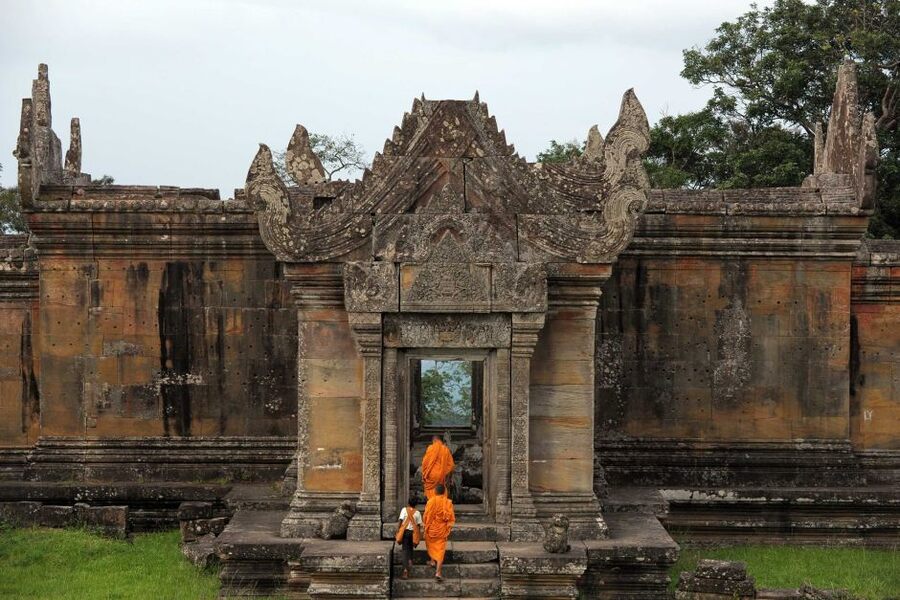
(Source: Sabai Adventure Cambodia)
Preah Vihear is an ancient temple in the North that most tourists may be surprised to learn that it is the second UNESCO World Heritage Site in Cambodia.
.jpg)
Preah Vihear is an outstanding masterpiece of Khmer architecture. (Source: Siem Reap Shuttle Tours)
The temple was built to honor the Hindu god Shiva and is considered one of the most important sites of the Khmer Empire. This temple complex includes a series of shrines connected to each other through a system of paved roads and steps leading up to the shrine. The entire temple complex is unique, featuring distinctive architectural features of a bygone Khmer golden age, while adapting to the natural terrain and serving its religious purpose.

Explore this sacred sanctuary for an unforgettable experience. (Source: Visit Koh Rong)
How to get there: Preah Vihear is pretty remote - over three hours of good road from Siem Reap. From Siem Reap, hired private cars ($40-60) are most comfortable, minivans are a budget-friendly alternative ($20-30), taxis are faster but pricier ($80-100), and motorbikes offer adventure ($10-15). From Phnom Penh, hired private cars ($100-150) are quicker, while buses are cheaper but slower ($20). These prices may vary from time to time.
Koh Ker is a remote temple complex that was built in the 10th century. It was known as the capital of the Khmer Empire between 921-944 CE. Ancient documents record that, during the chaos, King Jayavarman IV built this pyramid as both a temple and a military training ground. The structure fell into oblivion just a few years after it was built, as the succeeding king abandoned Koh Ker shortly after ascending the throne to move the capital back to Angkor.
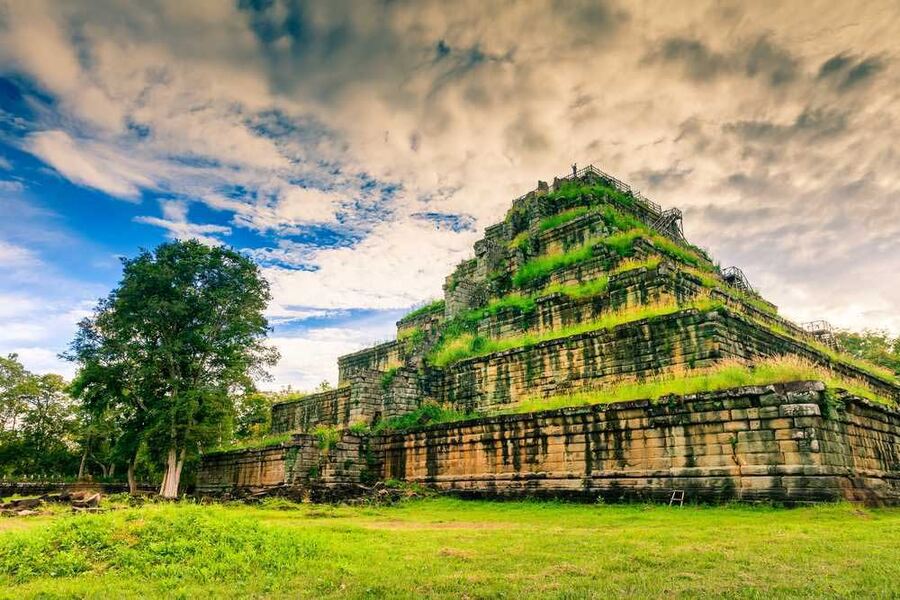
Koh Ker - The old capital of the Khmer Empire. (Source: Visit Koh Rong)
Although it only existed for a short period, Koh Ker managed to create some spectacular architectural structures and massive sculptures. The site features several impressive structures, including one of Cambodia’s biggest, a seven-tiered pyramid called Prasat Thom. Visitors can explore the ruins of the temple and learn about its history and significance.
.jpg)
Brick-built towers in Koh Ker Temple complex. (Source: Project Expedition)
How to get there: From Siem Reap, hired private taxis ($50-100+) are most convenient, while shared taxis are cheaper ($20-30) and buses are the least expensive ($5-10). From Phnom Penh, private taxis ($100-200+) are faster, and buses are cheaper ($10-20) but slower. These prices may vary from time to time.
You may also like: 10+ Interesting Facts about Angkor Wat Temple Cambodia
Beng Mealea, like all Angkorian temples, was originally built as a Hindu place of worship – and like most of them, it was built of sandstone. This place is said to have once been a powerful dynasty under the reign of King Suryavarman II. He is also the author of the world's greatest masterpiece - Angkor Wat.
After the king died, his dynasty also sank into oblivion, no one could explain his disappearance or the secrets of this dynasty. What is clear is that it was one of the largest temples of the Khmer Empire, built in the same layout as Angkor Wat.
.jpg)
Beng Mealea still retains its unique and attractive architectural features. (Source: Best Price Travel)
A newly constructed road to the Koh Ker temple complex, passing right by Beng Mealea, has made the temple more accessible to visitors – but it’s still not on the radar for most temple-tramping tourists. The temple's central gallery had collapsed, with vines and tree roots taking over the walls and walkways. A wooden path leads to the central area and some outer galleries, but much of the temple can only be explored by climbing over fallen stones and scaling the walls.
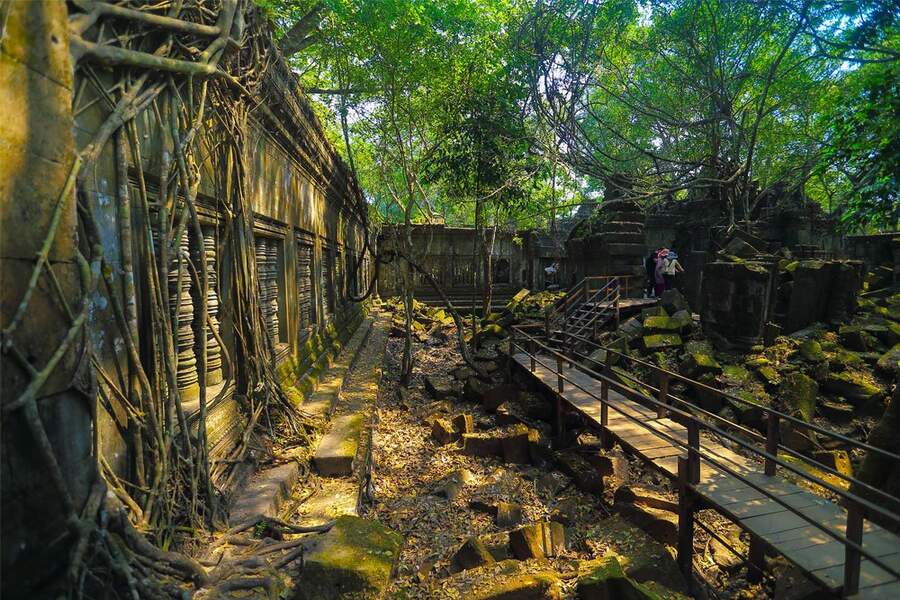
The alluring beauty of walls overtaken by nature. (Source: Tours By Jeeps)
How to get there: Visitors can reach Beng Mealea by Tuk-tuk or car. Remember that this location is close to Koh Ker, so you can arrange to visit both at the same time.
Located about 150 kilometers from Siem Reap, the historical and cultural site of Sambor Prei Kuk is one of the most ancient temple complexes in Cambodia. In Cambodian, Sambor Prei Kuk means "temple in the jungle”. Sambor Prei Kuk is Cambodia's third UNESCO World Heritage Site, along with the ancient ruins of Angkor and Preah Vihear temple.
.jpg)
Sambor Prei Kuk, "temple in the jungle”. (Source: Cambodia Begins at 40)
Sambor Prei Kuk is considered the first capital of the Chenla Dynasty during the "pre-Angkor" period, known as Ishanapura, reigning from 550 - 598 AD. This place was once a thriving ancient civilization in the late 6th and early 7th centuries, with more than 20,000 households living before the Khmer Empire was born.
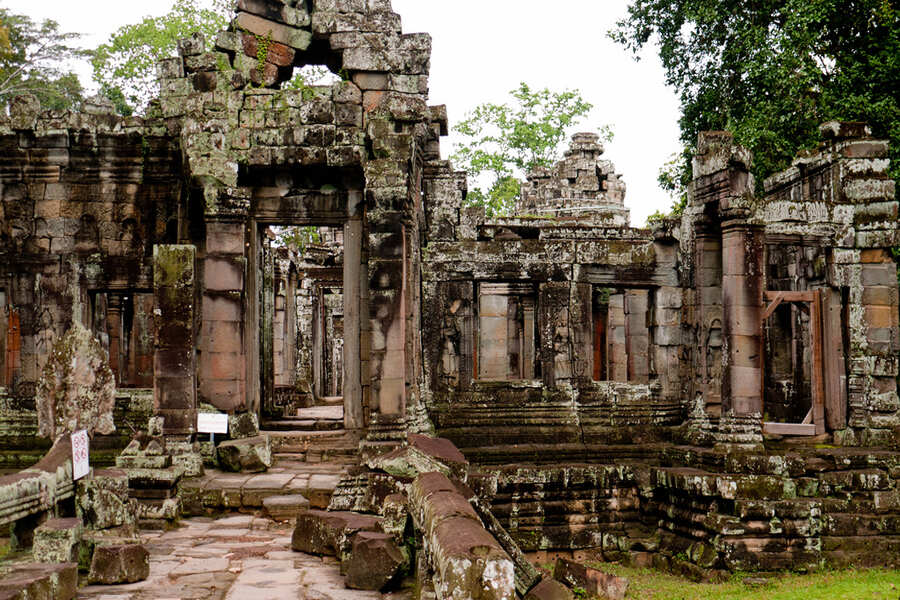
Despite decay, the still-standing temples display authenticity in form and design and demonstrate Indian cultural and architectural influence. (Source: Kyluc.vn)
How to get there: From Phnom Penh, you can take a 4-hour bus ride for $10-15, while from Siem Reap, taxis offer a quicker 2.5 to 3-hour option ($50-60), with buses being a slower, more budget-friendly alternative. These prices may vary from time to time.
Banteay Chhmar Temple was an ancient site in the Angkorian period (802 - 1432), located in Banteay Chhmar commune. It's about 110 km from the Angkor World Heritage Site in Siem Reap province. Because it is completely separate from other works in the Angkor complex, Banteay Chhmar is rarely visited by tourists.
The desolation and solitude make the ruins, antiquity, and serenity on the unique sculpted walls in Banteay Chhmar more mysterious and attractive. And over time, the roots of the ancient trees clung tightly to the wall, as if merging into the structure.
.jpg)
The forgotten temples of Cambodia's Banteay Chhmar. (Source: CNN)
A particularly impressive thing that Banteay Chhmar brings to visitors is the famous carved image of Bodhisattva Avalokiteshvara. Stone conservator Simon Warrack, who has studied Cambodian temples for more than 20 years, estimates that hundreds of meters of carvings have fallen over time, leaving behind a mysterious question for historians and archaeologists. Additionally, there are countless Buddhist images and startling bas-reliefs of Angkorian-era life that signify its importance as a temple complex.
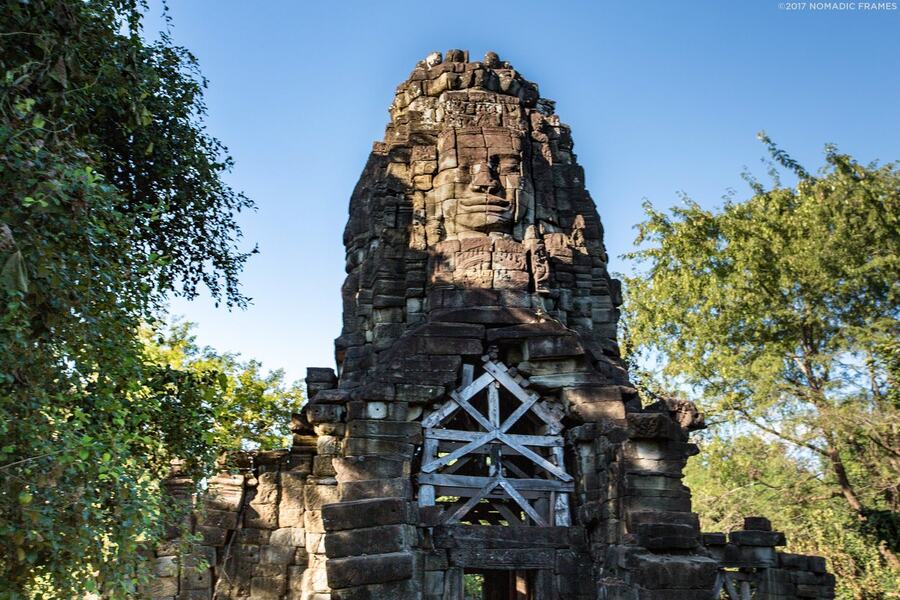
The faces have four sides, representing Brahma's four faces. (Source: Nodamic Frames)
How to get there: To reach Banteay Chhmar, travel first to Sisophon, a major transit point, which is 8 hours from Phnom Penh, 2 hours from Siem Reap, and 1 hour from Poipet. From Sisophon, it’s a 65 kilometer journey by taxi, pickup, or moto to Banteay Chhmar, taking around 1 to 1.5 hours.
Wat Ek Phnom, or Ek Phnom Pagoda, is located 8 km north of Battambang city and has the ruins of an old temple from the 11th century in front of a modern pagoda with a giant Buddha figure. This temple is not only known for its unique architecture but also serves as an open-air museum that tells the story of the Angkor period.
.jpg)
Paranomic view of Wat Ek Phnom. (Source: Travelsetu)
Wat Ek Phnom is a sandstone sanctuary, following the concept of Angkor temples. Its moat, which is one of the elements that contribute to its beauty, has been an important feature for Buddhist monks, as they’ve used it for ceremonies for centuries.

Wat Ek Phnom followed the concept of Angkor temples. (Source: Templeseeker)
How to get there: Ek Phnom is easy to reach by heading north on River Road (Road 1) for about 10 kilometers, passing a small concrete bridge. The modern temple is on the left, with the ruins located at the back; you can use a moto, tuk-tuk, or taxi from Battambang.
Prasat Kravan is a 10th-century Hindu temple in Angkor, that the Khmer people built out of devotion to the supreme Lord Vishnu. “Prsasat Kravan” can be translated as “artabotrys odoratissimus temple” in Khmer.
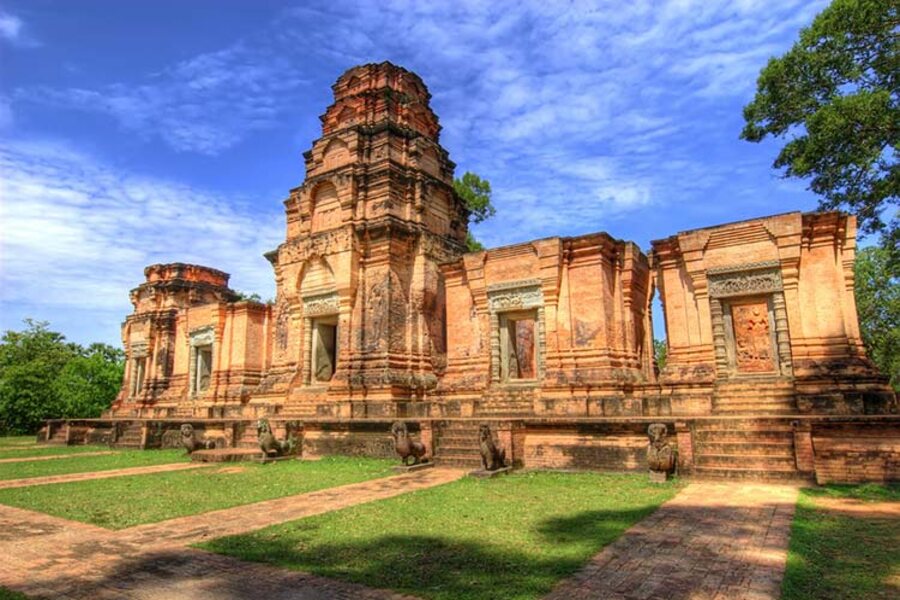
10th-century Hindu temple dedicated to Vishnu. (Source: Renown Travel)
Prasat Kravan has a total of 5 towers, of which the tower in the center worships the god Vishnu. This temple complex is 800 meters long along the North - South axis, with a high wall and steps leading up to the majestic shrine located in the South. Basically, Prasat Kravan has a structure quite different from other mountain temples, but has the same purpose of worshiping the gods at Meru peak. It is because it was not built by the royal family, which is why its location is somewhat remote and far from the country's center.

The principal shrine was dedicated to a cosmic form of Hindu god Vishnu. (Source: flickr)
How to get there: To reach Prasat Kravan Temple, you can hire a tuk-tuk or rent a bicycle from Siem Reap. The temple is located about 5 kilometers south of Angkor Wat, making it easily accessible for those exploring the Angkor temples.
There are numerous rules and customs to be aware of when exploring temples and pagodas. Here are some tips and notes for your reference.
Research before you go: Each temple or pagoda has its own opening hours and ticket prices. It’s important to familiarize yourself with this information so you can plan your itinerary accordingly. Additionally, you should learn about the ticket purchasing process. Remember, it is important to carry your passport when purchasing.
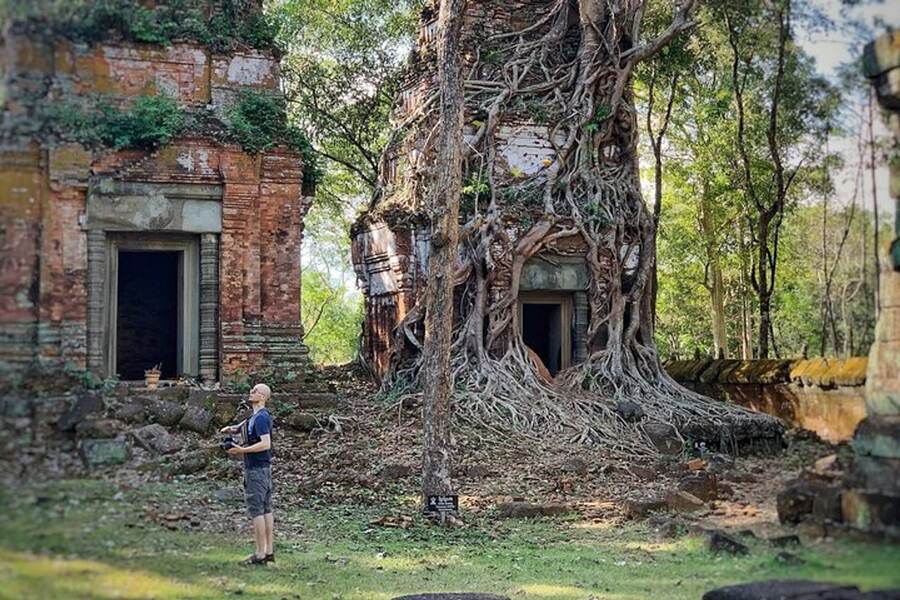
Prepare ahead for better experience. (Source: Pelago)
Dress modestly: Any tourists coming to Cambodia, especially during festive periods, should wear discreet and polite clothing. This includes avoiding revealing clothing, shorts, and tank tops. This will ensure a warm welcome.
This “dress code” is even stricter when visiting temples or pagodas because these are extremely sacred places that must be respected. Therefore, you should prepare your clothes carefully if you plan to visit any spiritual areas. Before entering the temple, remember to leave your shoes outside. This is also a common tradition when entering Cambodian houses. Once inside, avoid pointing your feet towards any Buddha statues or images.
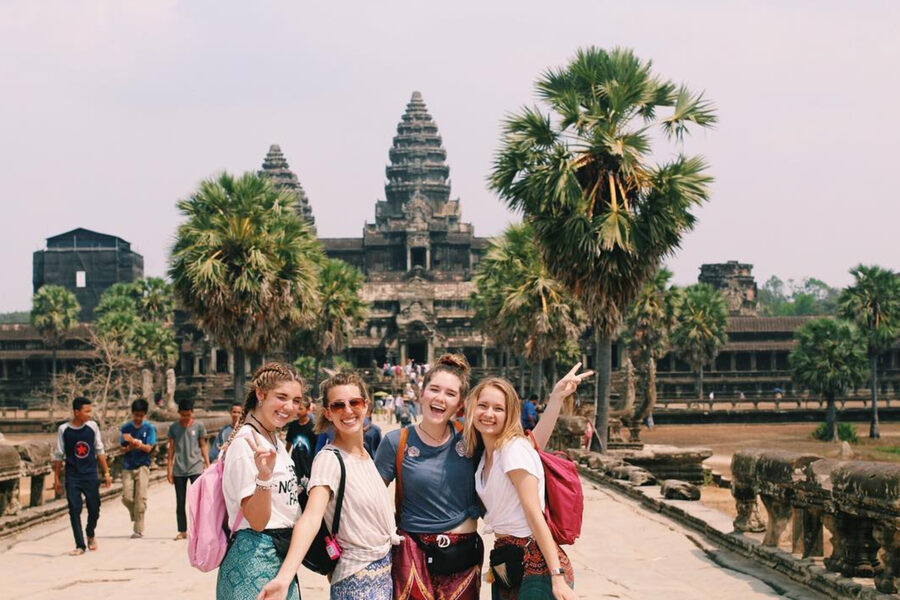
Prepare your clothes carefully if you plan to visit any spiritual areas. (Source: ILP Blog - International Language Programs)
Act respectfully with monks: In Cambodian culture, monks are greatly admired and respected. It is important that you treat them with the highest respect. For women, touching a monk or novice is strictly forbidden and considered highly inappropriate.
In addition, ladies should be careful not to unintentionally brush against a monk's robes whether sharing a tuk-tuk, on the street, or within a temple. It is also common for women to send items through a male middleman rather than giving them directly to monks.
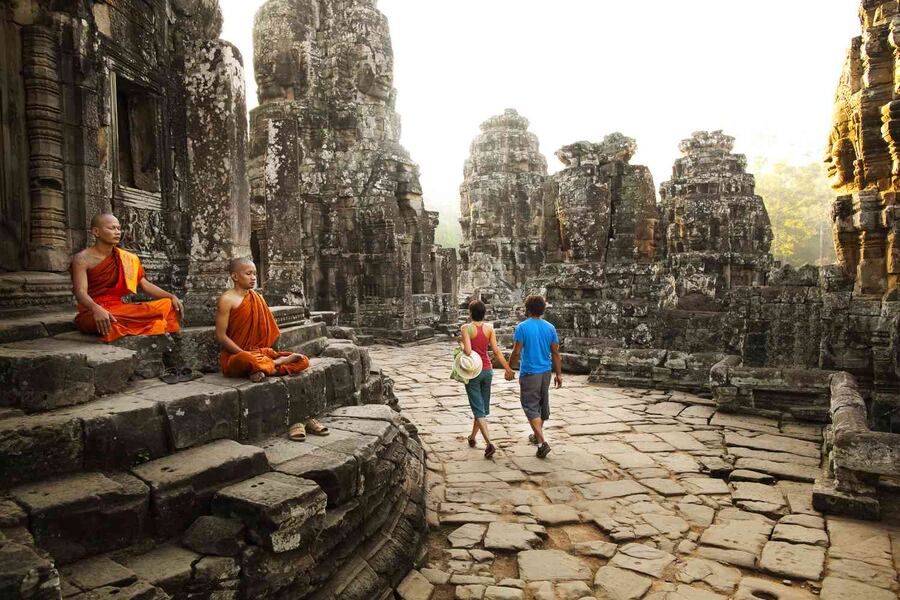
Remember to treat monks with the highest respect. (Source: TripSavvy)
Here are some mysterious temples that Asia King Travel wants to introduce you to. These ancient structures, though less known than Angkor Wat, are equally mysterious and significant, reflecting the Khmer Empire's architectural and spiritual mastery. Visiting these remote sites lets travelers connect with Khmer heritage and enjoy Cambodia's serene landscapes. With any luck, this may spark your curiosity and motivate you to arrange a visit to these incredible temples.
You may also like: Explore the most beautiful pink stone Temple in Cambodia - Banteay Srei temple